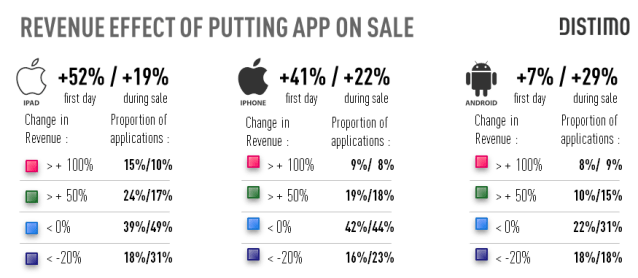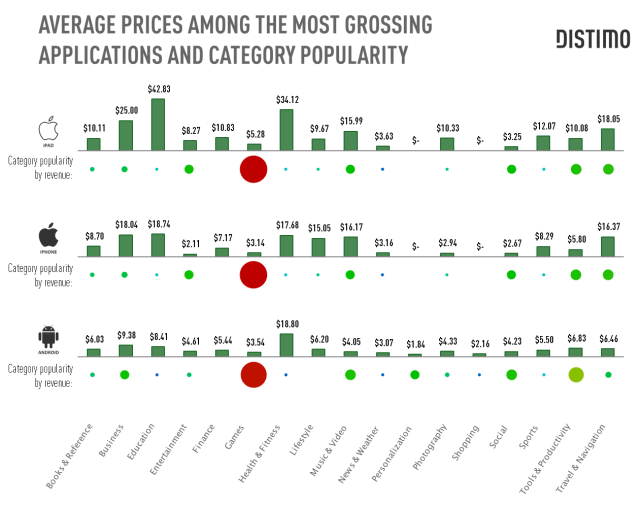In a new research report from Distimo, the app store analytics provider examined two different ways that allow mobile developers to get a bump in both their download numbers and revenue. One way, which is within the developers’ control, is putting the app on sale. Within the first day, iPhone developers see an average increase of 41% in revenue using this method, and see revenue increases of 22% by the sale’s end. Android apps, however, rose just 7% on day one, but closed out the sale with higher percentage gains than either iPhone or iPad.
The second method Distimo looked into is getting the app featured in the app store. This is up to the app store’s operator, like Google or Apple, of course. (We’ll examine Distimo’s findings on featured apps in a subsequent post).
When a developer decides to put an application on sale, there’s a delicate balance that has to be achieved. The sale price has to be low enough to encourage more downloads, obviously, but it also needs to be low enough that it encourages enough download volume to make up for the lost revenue.
To examine what happens during when apps go on sale, Distimo examined the 100 top grossing apps in the iPhone App Atore, iPad App Store and Android Market. On the first day of the sale, the average revenue increase by +41% in the iPhone App Store, and by 15 days in, was up by +22%. On the iPad App Store, the day one effect was even greater: up +52% on day one and up +19% by day 15.
But the boost in the Android Market was the largest of all, although this couldn’t immediately be seen. By day one, revenue was just +7% on average, but by day 15, it was up +29%. These are percentage increases, though – not dollar amounts.
Keep in mind, too, that these gains are averages. Not all developers were so lucky. In looking closer at the numbers, Distimo found that 44% of iPhone apps lost revenue during the sale, with 23% seeing a decline in revenue by more than 20%. This is why the sale price setting is key to maximizing the gains. For example, a discount of a dollar on a $7.99 app lowers the revenue, but a discount of $3 increased revenue by 131%. In general, the tipping point occurred when the app’s price was cut in half or the app was offered in Tier 1 ($0.99) or Tier 2 ($1.99).
The graph below shows what happens when prices were cut by 40%, 50%, 60%, 70% or 80%. The conclusion here is that it can pay to put an app on sale, but to actually earn more revenue, you have to make a significant price cut.
This all begs the question, then: what price should a developer ask? There isn’t a simple ratio to use. The right price depends a lot on what kind of application it is, where it’s sold, what category it falls into and its overall complexity. Simple apps that are easy to make (and copy) are priced lower. You can see the variations by revenue, category and app store here:
Since this is a lot of info to take in, we’ll look at Distimo’s findings related to apps being featured in the app store in a separate post. You can find the full report here.



